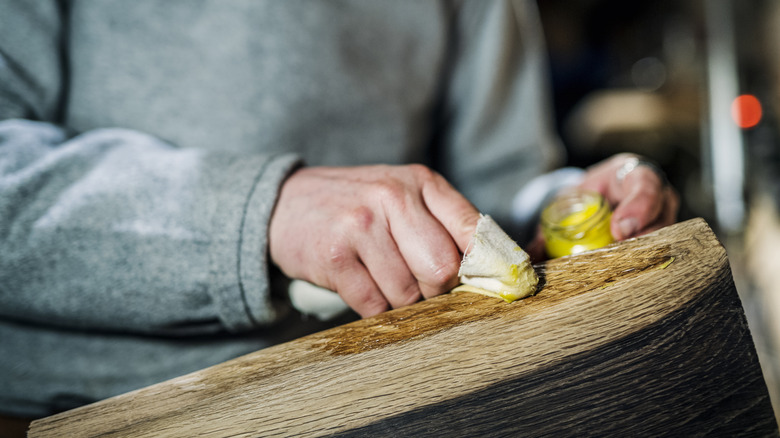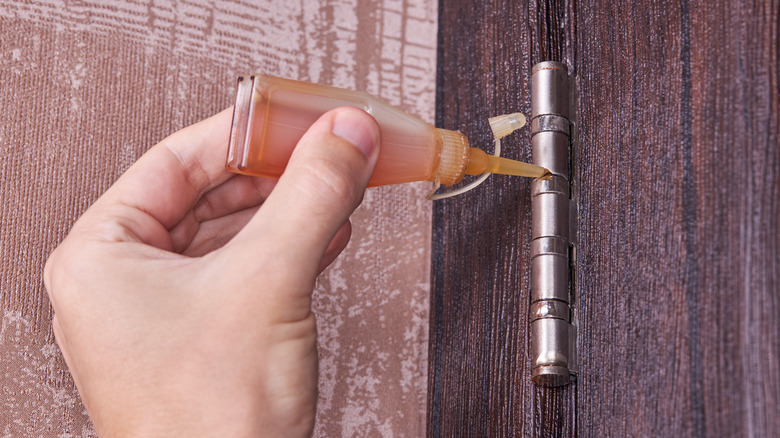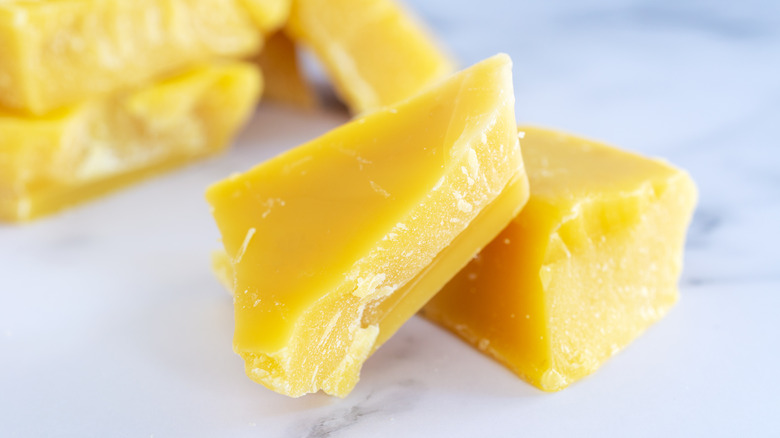Is Beeswax A Good Substitute For WD-40?
We may receive a commission on purchases made from links.
WD-40 has been on U.S. hardware store shelves since the late 1950s; today, many consider it a household staple. It's typically used for stopping things, like door hinges and drawer slides, from squeaking or sticking and keeping machinery moving. You can use beeswax to fulfill some of these applications but not all, making its usefulness as a WD-40 substitute somewhat ... complicated. First, we need to examine these lubricants' similarities and differences.
The "WD" in WD-40 stands for "water displacement," a function common to all lubricants; the "40" references the 40th (and final) formula. According to Wired, the lubricant is a mixture of mineral oil, carbon dioxide (the propellant), and a solvent called dimethyl naphthalene. It also contains a bunch of compounds called alkanes — think cyclohexane, decane, nonane, and tetradecane — to keep WD-40 liquid or make it freeze and water repellant. Does WD-40 ever expire? Not for ages if stored correctly.
To say beeswax has a long history as a lubricant is an understatement. The insect-made substance was used to keep all kinds of machinery moving in the ancient world. It's been a go-to grease for guns pretty much since their invention. As the name suggests, beeswax is secreted by honeybees to build their nests. Like WD-40, beeswax is also long-lasting and hydrophobic, but unlike its synthetic counterpart, it's completely natural and biodegradable — sometimes to its detriment. It hardens to brittle if the temperature drops below 64 degrees Fahrenheit.
Buzz or bummer
Expert advice on whether beeswax is a good WD-40 substitute is confusing, to say the least. Dave Gutz, a retired mechanical engineer formerly with GE Aviation, replies to the Quora thread, "What should I use besides WD-40 on my sliding screen door?," that he prefers using beeswax over WD-40 for "the occasional sticky door, drawer, or window." Rocky Mountain Tree-Ring Research recommends using either product to lubricate borers used in tree-ring sample extraction. Making concrete casts? Use WD-40 or beeswax softened with a little heat as a mold release agent.
One commenter on a 2015 thread posted to the expert forum Welding Design & Fabrication suggests beeswax instead of WD-40 for lubricating dry saws when cutting aluminum. Lifelong modeler Andy Leaning (per Model Railway Engineer) says to avoid using WD-40 to lubricate the moving parts on model trains. A reader replies in the comment section, suggesting beeswax as an alternative. Even the official WD-40 website in India suggests beeswax for greasing squeaky door hinges!
Jeff Wilson, an experienced lumber salesman and plumber turned journalist, includes both beeswax and WD-40 on his list of substitutes for silicone grease (via Journeyman HQ). However, he doesn't recommend beeswax for unforgiving or high-temperature environments. Sleep specialist Elisa Regulski, writing for Mattress Clarity, suggests using WD-40 on squeaky metal bed frames and on noisy wooden frames. Conversely, neither beeswax nor WD-40 is recommended for wooden spinning wheel lubrication, though WD-40 is suggested for freeing stuck whorls. Beeswax adds too much grip.
What for
What all this expert advice amounts to is that beeswax appears to be a suitable alternative to WD-40 in certain circumstances. Use it in place of WD-40 to reduce friction on your garage door stops, remove rusty bolts and loosen stuck screws, stop metal hinges from creaking, and help drawers slide easier. Apply it to metal surfaces and tools to repel water and prevent rust. The Texas Department of Transport advises using a stick of beeswax to lubricate connection bolts on bridges ... Yes, BRIDGES. As it has a pleasant odor and is non-toxic, it is also perfect for use in places that come into contact with food, such as the kitchen. You can even use it to extend the life of your wooden kitchen items.
If you prefer to use the highest quality beeswax, look for the words "cosmetic grade" or "food grade" in the product description. This means the beeswax in question is suitable for use in the pharmaceutical and food processing industries and, therefore, free (or at least freer) of impurities and additives. Honey Lake Bee Co. sells a highly rated quarter-pound bag of U.S.-produced pure beeswax pellets for $9.45 with free shipping. Buy a 50-gram bar of pure yellow beeswax at Walmart for $8.76. You can also get beeswax products designed specially for lubrication. Hardwick & Sons sells a 2-ounce Beeswax Cake Lubricating Compound for $122. Finally, just under 1 ounce of Lundmark Bees Wax Lubricating Compound, an industry favorite, will set you back $6.90 on Amazon.


